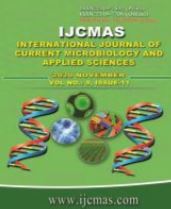


 National Academy of Agricultural Sciences (NAAS)
National Academy of Agricultural Sciences (NAAS)

|
PRINT ISSN : 2319-7692
Online ISSN : 2319-7706 Issues : 12 per year Publisher : Excellent Publishers Email : editorijcmas@gmail.com / submit@ijcmas.com Editor-in-chief: Dr.M.Prakash Index Copernicus ICV 2018: 95.39 NAAS RATING 2020: 5.38 |
Nanotechnology can offer green and eco-friendly alternatives for plant disease management. In this study, the investigation was carried out for the antifungal activity of silver nanoparticles against the pathogens involved in the rhizome rot complex such as Fusarium oxysporum, Pythium aphanidermatum, Sclerotium rolfsii, and Ralstonea solanacearum. Metal nanoparticles of different concentrations such as 1 ppm, 5ppm, 10 ppm, 15 ppm, 20 ppm, 40 ppm, 50 ppm, and 100 ppm were treated against the pathogen complex by poison food technique as well as agar well method to determine the antimicrobial activities in vitro. Observations were recorded 12 hr, 24 hr, 48 hr, and 72 hr of pathogen inoculation. Application of 100 ppm concentration of silver nanoparticles produced maximum inhibition of the growth of the fungal as well as bacteria. However, 15 ppm, 20 ppm, 40 ppm, 50 ppm were also effective as compared to control. Microscopic observation revealed that nanoparticles caused damage effects on fungal hyphae and conidia. The study also revealed that the antifungal effects of silver nanoparticles are positively correlated to the concentration of nanoparticles as well as the time of exposure. Further, it can be exploited as an alternative for chemical management in the future.
 |
 |
 |
 |
 |